STUDENTS PROJECTS
PROJECTS2013
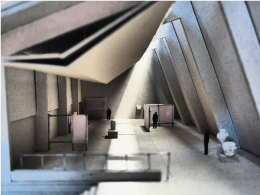
15 April, 2015
Archaeological Museum for the Neighbourhood of Plato’s Academy
Archaeological Museum for Plato's Academy area and the Facilities of 3rd Department of Antiquities.
Students : Xristina Polixronopoulou, Spania Elli
Professor : Τasis Papaioannou
N.T.U.A
Presentation date : 07/11/2014
The project develops the design of an archaeological museum in the neighborhood of the Academy of Plato in Athens. Finding the connecting link between the two worlds that coexist today in this place has been our inspiration from the start. A connector between the vivid city park and the archaeological potential which remains unseen and unattended.
In the park of the Academy of Plato, we spotted a very lively park and a hidden archaeological value which is not related to the daily life of the park today. Antiquities remain hidden behind tall fences of warehouses and even the archaeological remains in the park are unattended. Finding the link between these two worlds that we perceived after visiting the area, led, progressively, to the design of an archaeological museum that attempts to bring forward the ancient world, maintaining the vitality and spirit of today's life in the area.

About the current characteristics of the region we have noted:
- The park has great natural beauty with many species of vegetation typical in the Attica region. It is an island of greenery in the dense urban tissue; important both for the neighborhood and the city. Thucydides describes the region as "one of the most beautiful suburbs" of ancient Athens.
- Northwest of the park (Botanicos area) we find industries, warehouses, garages. Also along 'Athinon' road we have offices of large companies. On the Southeast side-Lenorman road- we have organized residence areas. A mixing of functions is featured between these two regions. Many empty plots include parking places for large vehicles, etc.
- Street Dracodos (bus 051) divides the park in two. The tall vegetation and fences make it difficult to orientate and perceive the park at its full extent.
- The 'Rents' plot is an open excavation without significant findings which remains unused since it was excavated.
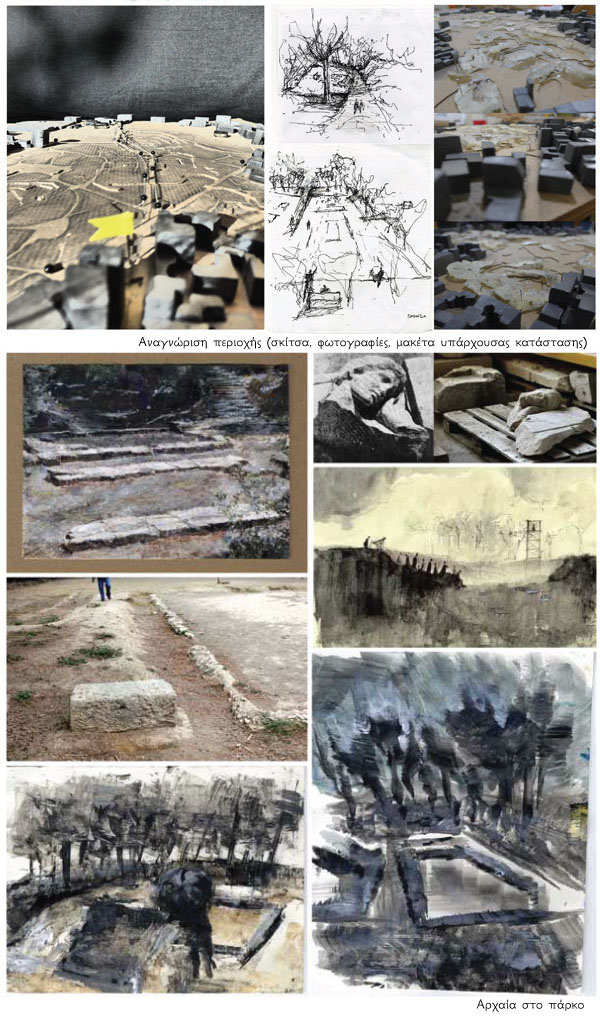
- Spolia are scattered in the park and used as sitting benches.
- We have architectural findings from different historical periods (Gymnasium, geometric house, 'holy house', Peristyle) that seem rather unimportant in the contemporary reality of the park. The neglected vegetation is not helping and today only the information signs indicate their presence. This, combined with the large number of archaeological warehouses that exist in the surrounding area of the park and remain hidden from the visitor, degrades the archaeological value of the site.
- Lots of residents's activities are organized in the park weekly.
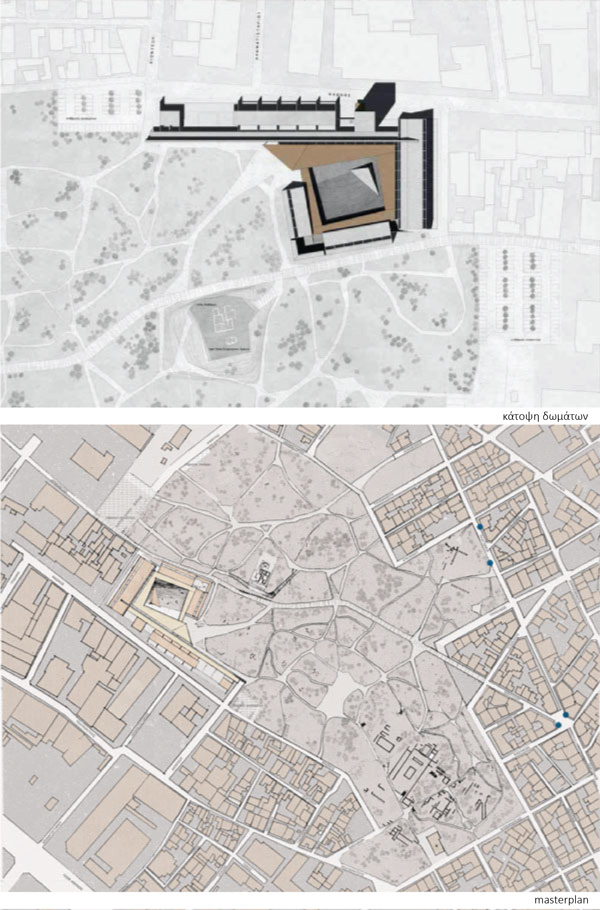
Firstly, we pointed the need for reorganization of warehouses and improvements workplaces archaeologists(which are mostly ephemeral structures today). In the direction of connecting the modern life and archaeological potential, we set to design exhibition areas and a core that is open to the general public and not only archaeologists who work in the area.
W considered it necessary to create a coherent unity for the functions of the 3rd Department of Antiquities(warehouses/workshops/offices)which will replace the current temporary structures.
At the same time, we considered how the visitor may be rendered able to appreciate the work that takes place daily from the archaeologists and also take notice of the wealth of findings that remain in storage.
Interventions in the park include joining the two parts of the park together( Kratylou str turns into a pedestrian street and 051 bus line is being diverted). The fencing is removed and there is a study made on basic accesses and parking areas for visitors and employees.
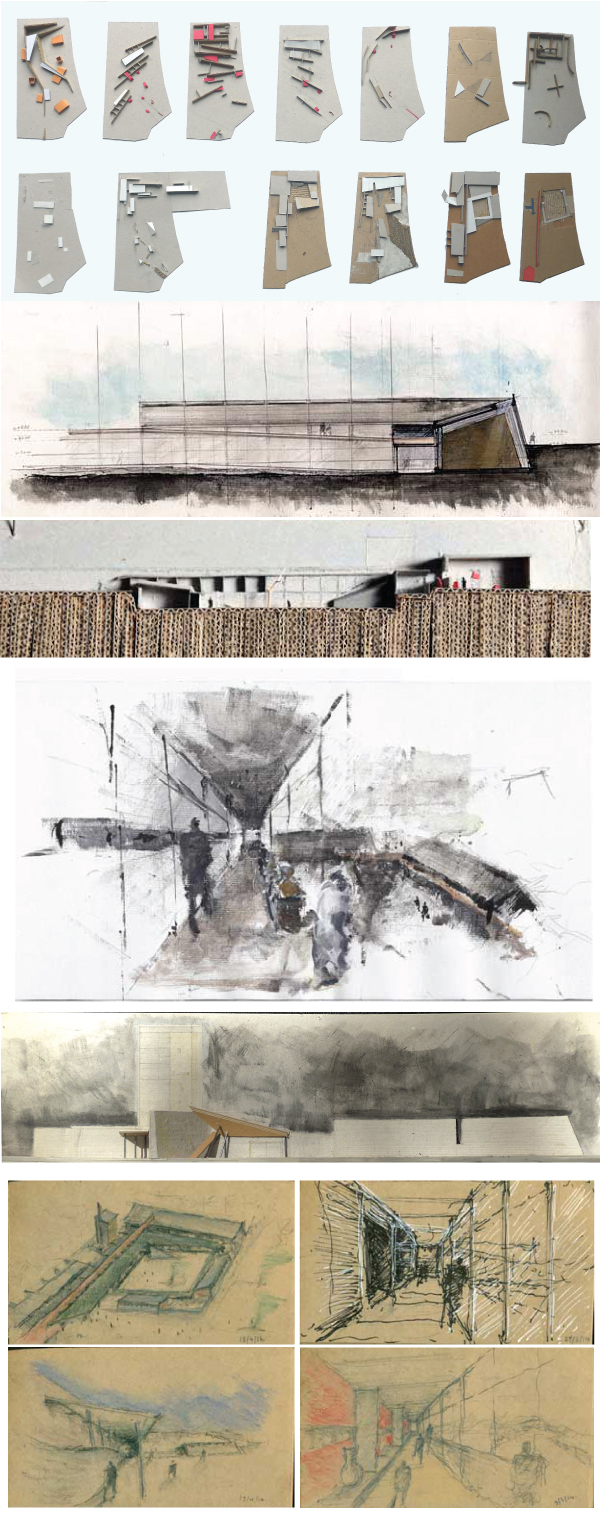
Forming a dual entity, our building, reflects both its different but complementary functions which are the Archaeological Museum and the facilities of 3rd Prehistoric and Classical Antiquities Department ( including storage, research, maintenance, administrative functions, conference rooms, etc.) .The exhibition areas include a unit concerning Plato's Academy and a second one of temporary exhibitions.

The wall is the architectural tool that gives direction and defines the two sections. The cohesive unit of warehouse/workshops/management is developed on the city side. The storage areas are found in the end of the straight path that is defined by the wall and receives the load of movements and transfers of this unit. The storage areas are potentially visitable. The tower, with the museum's administrative functions, is functional accessible from both units. In the museum unit, the grid is rotated by some degrees to open up towards the park. The idea of a descent to the past to approach the ancient world blends with the basic spiral movement which takes you from the level of the park to the exhibition rooms and then to the museum's restaurant, the amphitheater and the auditorium and, last but not least, the interior patio which forms the core of the museum. This spiral movement is completed with a climb to the ramps that form the roof, which is accessible to the public and offers views of the park and the city of Athens, even when the museum is closed.

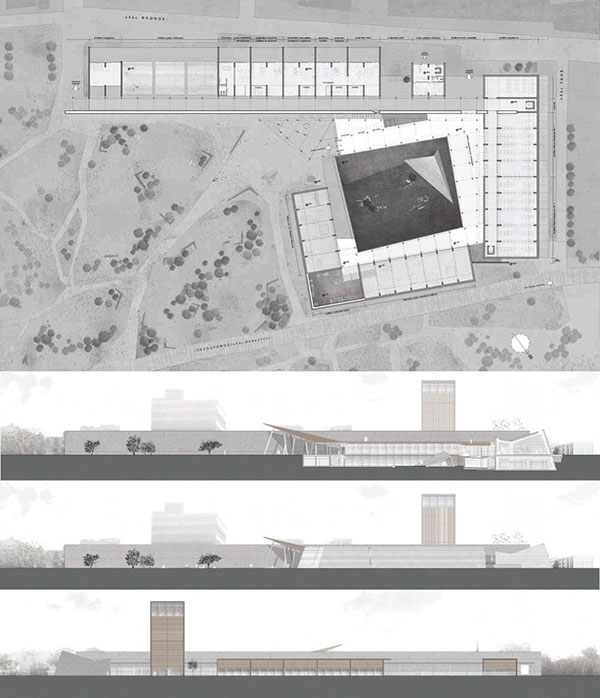
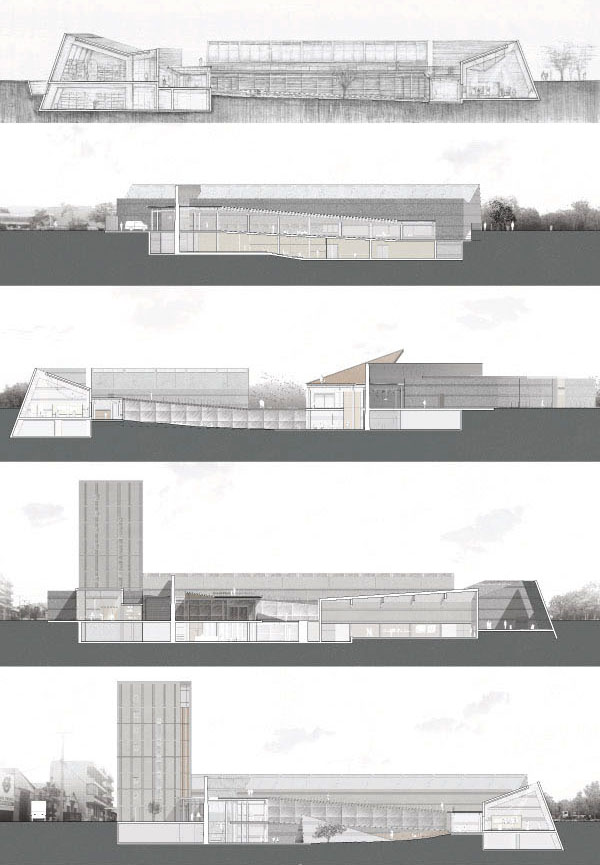
Related articles:
- DESTROY below the ACROPOLIS - VIDEO ( 13 November, 2007 )
- Architectural cannibalism in Athens ( 23 July, 2009 )
- The Acropolis Museum: An Unhappy Fit ( 08 June, 2010 )
- The New Acropolis Museum: A Triumph of Sophistry ( 21 September, 2009 )
- Αrchitectural competition ( 13 March, 2009 )
- D. Areopagitou 2008: reformation competition of the rear views of historic buildings towards the new Acropolis Museum ( 25 July, 2011 )
- New Acropolis museum ( 06 January, 2013 )
- All about fish ( 14 February, 2013 )
- New Acropolis Museum (NAM) ( 07 October, 2013 )
- The archaeological museum of Ancient Messene and the architectural configurations of the archaeological site ( 08 January, 2014 )
- Redefining Leftovers ( 05 April, 2014 )
- Theatre complex at Koukaki, Athens ( 20 January, 2014 )
- Reformation and rehabilitation of an inactive quarry, with spatial location of uses for Tourism, Recreation and Environmental Education ( 10 February, 2014 )
- Cultural center of Glyfada ( 23 February, 2014 )
- Environmental Center and Cultural Center in Kaiafa’s Lake ( 21 March, 2014 )
- The rack railway museum at Vouraikos gorge ( 18 April, 2014 )
- Museum of underwater antiquities in Chios ( 01 June, 2014 )
- Archaeological museum in Astypalaia ( 03 November, 2014 )
- Art multiplex in the Customs Office area in Palaia, Volos ( 24 February, 2015 )
- Diploma projects exhibition museum of school of architecture ( 02 March, 2015 )
- Lighthouse Museum in Andros ( 20 April, 2015 )
- Palazzo di Lorenzo’s Museum in Sicily ( 15 May, 2015 )
- New Archaeological Museum of Delos ( 19 July, 2015 )
- Archaeological Museum of Eleftherna ( 01 September, 2015 )










